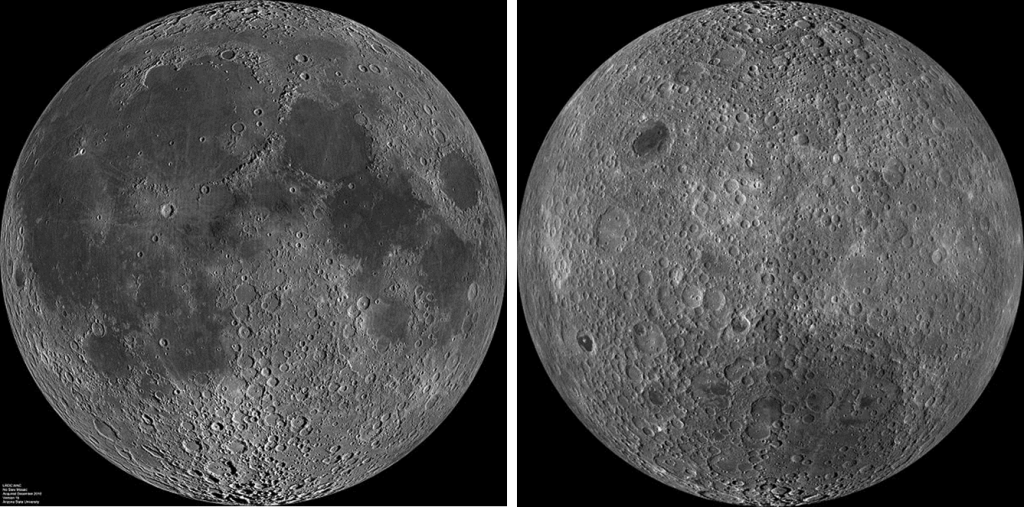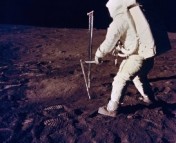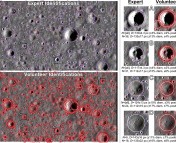- Title: Earthshine on a Young Moon: Explaining the Lunar Farside Highlands
- Authors: Arpita Roy, Jason T. Wright, Steinn Sigurdsson
- First Author’s Institution: Penn State University
You have only ever seen one side of the Moon. The moon is tidally locked, so its rotation and orbital periods are the same, and it keeps the same side always pointed towards the Earth. Thus, the Moon has a “near side” and a “far side”. The far side is sometimes referred to as the “dark side” of the Moon, but this is a bit of a misnomer, as it actually gets just as much sunlight as the near side.

The near side (left) and far side (right) of the Moon. The far side has very little maria due to its thicker crust. Images from Wikipedia.
When we finally saw the Moon’s far side with spacecraft, we noticed that it actually looks quite different from the nearside. The near side has large dark patches called “maria” formed by ancient volcanic flows, but very few maria exist on the far side. The far side has thicker crust, making it more difficult for magma to reach the surface. This difference in crust thickness is called the Lunar Farside Highlands Problem. Although scientists have posited many possible explanations for the Lunar Farside Highlands Problem (see this astrobite for one hypothesis), no consensus has emerged. Today’s paper presents a new plausible solution to this problem.
Before we get into the details of this new idea, let’s review how (we think) the Moon formed. Shortly after the proto-Earth formed, it was struck by another object roughly the size of Mars. This collision was extremely energetic, melting or vaporizing most of the two colliding bodies and unleashing a spray of material into space, much of it in orbit around the Earth. This material then coagulated into a single object that cooled and became the Moon.
The new theory takes a closer look at this last stage, when the orbiting material had coagulated into a single object and was beginning to cool and solidify. The authors’ first insight was that the Moon became tidally locked to the Earth very quickly — probably less than 100 days after it formed — while both the Moon and Earth were still hot and molten.
The authors’ second insight was to account for the effect of the hot Earth’s proximity to the Moon as it cooled. The Earth was still very hot at the time (probably around 8,000 K), and the Moon and Earth were closer together than they are today (the Moon has been steadily moving away from the Earth due to tidal interactions between them, which also acts to slow Earth’s rotation). Hot objects emit radiation, and at that time the amount of energy the Moon received from the hot Earth was far greater than what it received from the Sun. Because the Moon was tidally locked, all of this “Earthshine” energy was imparted onto the Moon’s near side. As a result, the near side cooled more slowly than the far side. For the first several thousand years at least, the far side of the Moon really was the dark(er) side.
At this time, the Moon was still covered with magma oceans and surrounded by a thick atmosphere of rock vapor. As the Moon cooled over thousands of years, materials began transitioning from vapor or liquid phase into solids. The first materials to become solids were those with high melting temperatures called refractory materials. As a consequence of the difference in cooling rates, refractory materials (especially Al and Ca compounds) began forming the Moon’s solid crust first on the far side, while the near side remained too hot. This head start on the crust-building process lead to the Moon we see today: a near side with thinner crusts and more maria.
Further investigations using detailed physical simulations and a quantitative comparison with the evidence will undoubtedly need to be done before this new hypothesis can be declared the solution. But perhaps the explanation to this old mystery has been waiting (literally) right beneath our feet.





Trackbacks/Pingbacks